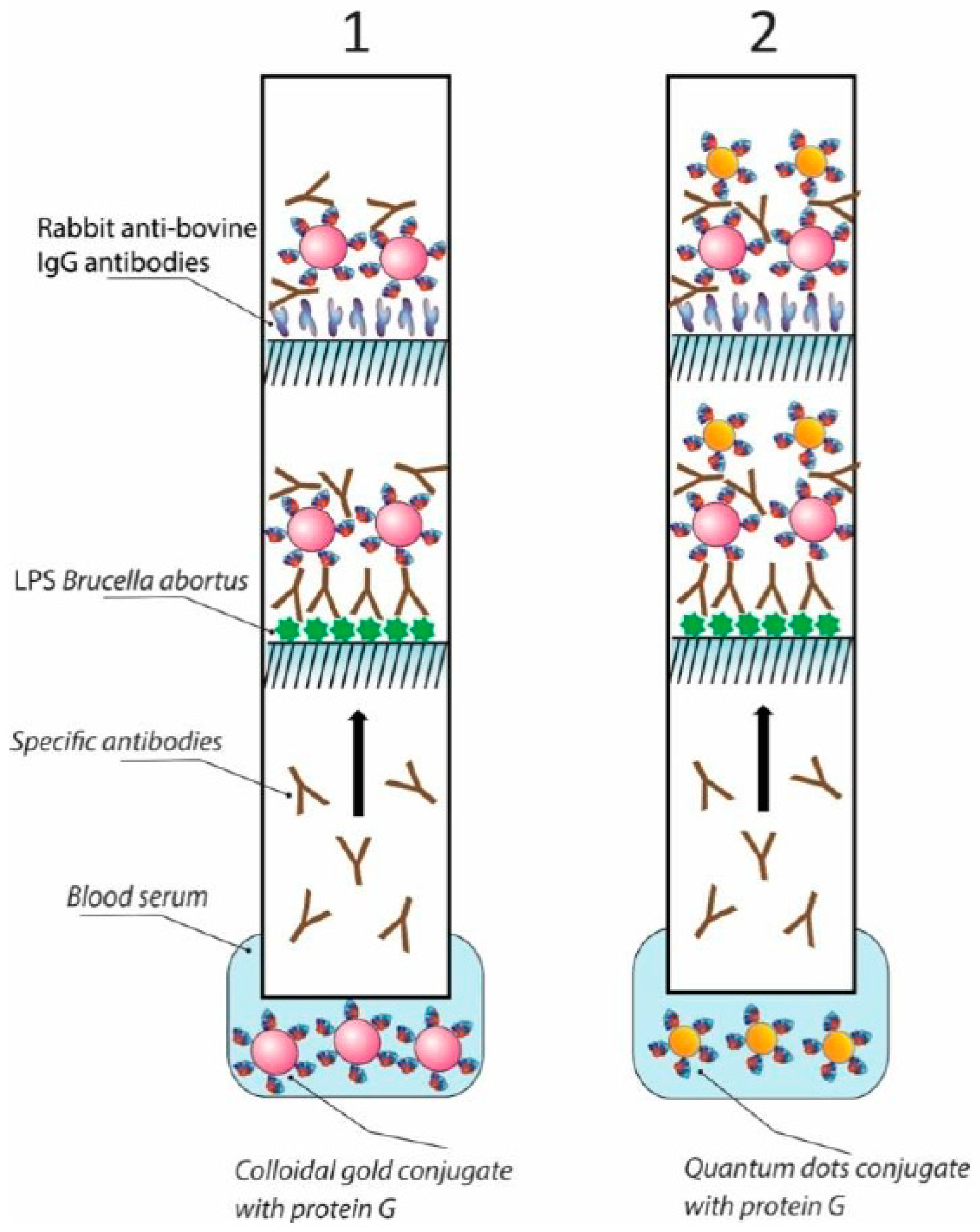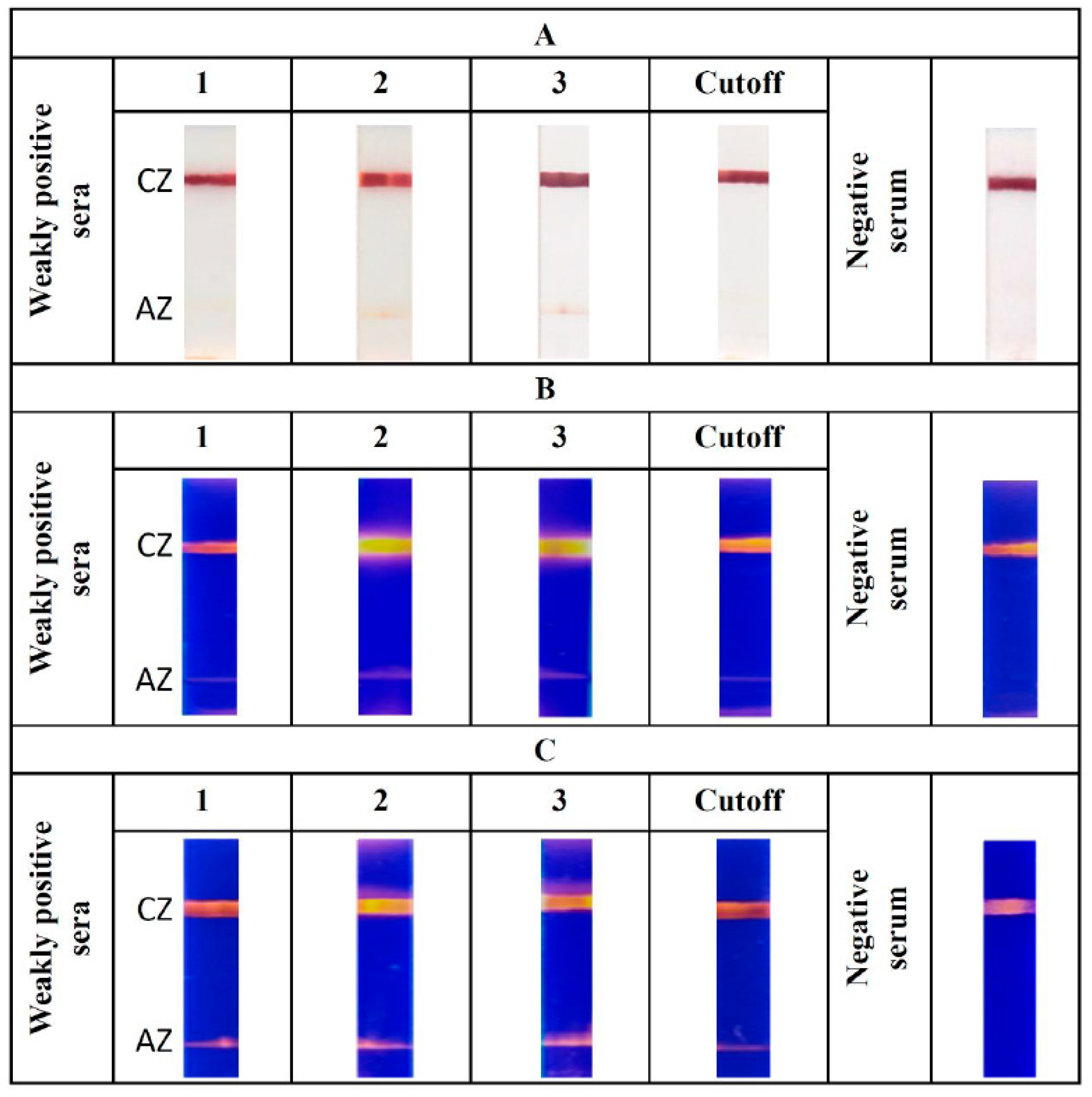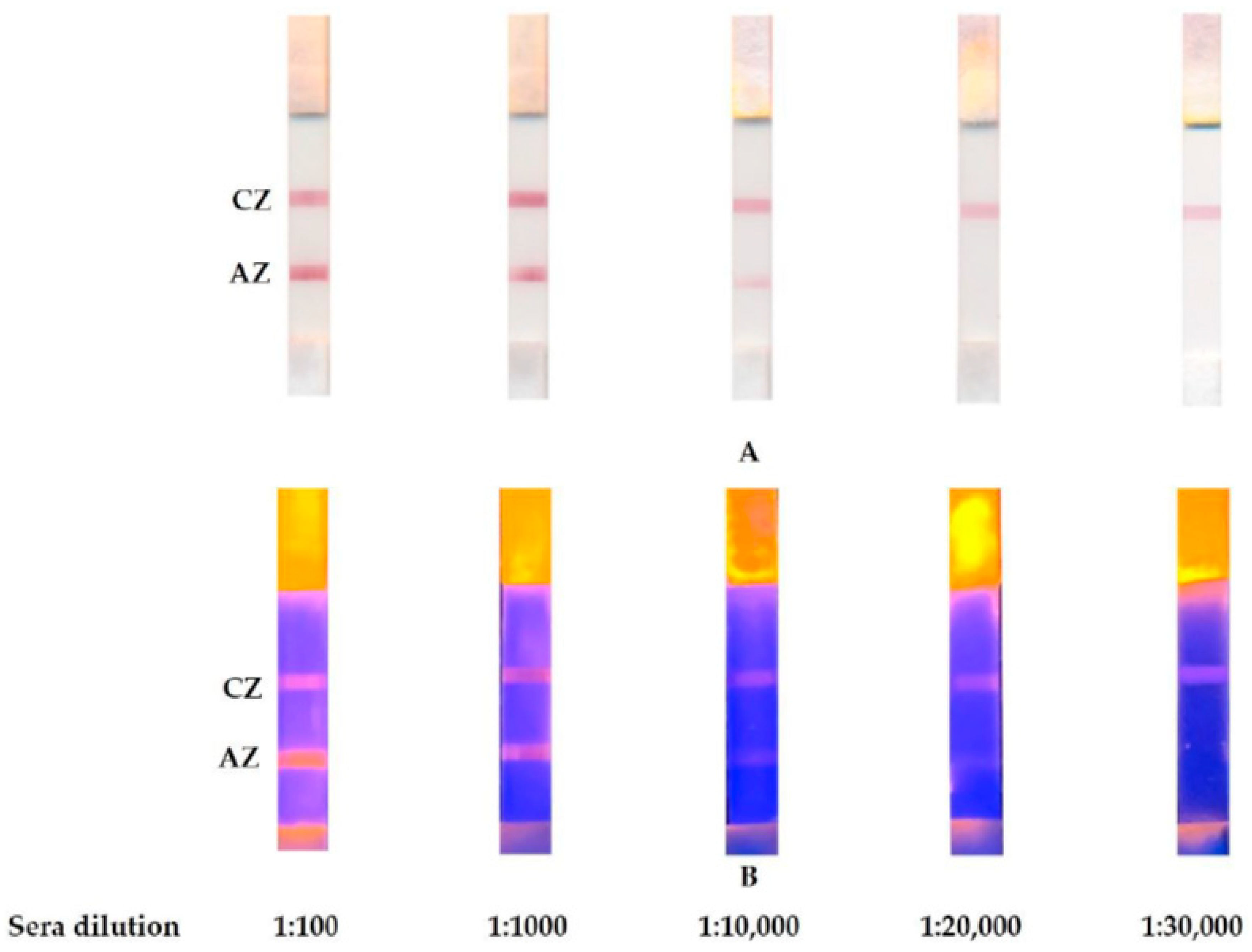Immunochromatographic System for Serodiagnostics of Cattle Brucellosis Using Gold Nanoparticles and Signal Amplification with Quantum Dots
Abstract
1. Introduction
2. Materials and Methods
2.1. Synthesis of GNPs
2.2. Synthesis of Conjugates of GNPs with Streptococcal Immunoglobulin-Binding Protein G
2.3. Preparation of Conjugates of QDs with Protein G
2.4. Cattle Serum Panel and B. Abortus Antigen Preparation
2.5. ELISA of Antibodies Against LPS of B. Abortus
2.6. Assembly of Immunochromatographic Test Systems
2.7. Immunochromatographic Detection of Antibodies against LPS of B. abortus
3. Results and Discussion
3.1. Characterization of Cattle Sera by ELISA Method
3.2. Optimization of the Concentration of GNP-(Protein G) Conjugate and LPS B. Abortus in the Immunochromatographic Serodiagnostics of Cattle Brucellosis
3.3. ICA on Cattle Sera with QD Amplification
4. Conclusions
Ethics Commitment
Author Contributions
Funding
Conflicts of Interest
Appendix A
| ELISA | ICA with GNPs | |
|---|---|---|
| D450 for 1000 Times Dilution of Serum | Coloration of Analytical Zone. rel. Units | |
| 1 | 0.657 | 9.6 |
| 2 | 0.653 | 8.3 |
| 3 | 0.47 | 1.1 |
| 4 | 0.458 | 16.4 |
| 5 | 0.547 | 9.3 |
| 6 | 0.98 | 25.4 |
| 7 | 0.705 | 15.4 |
| 8 | 0.559 | 3.5 |
| 9 | 0.531 | 5.5 |
| 10 | 0.548 | 3.4 |
| 11 | 0.511 | 8.0 |
| 12 | 0.722 | 16.8 |
| 13 | 1.096 | 24.2 |
| 14 | 0.392 | 2.6 |
| 15 | 0.303 | 3.0 |
| 16 | 0.859 | 14.2 |
| 17 | 0.893 | 23.2 |
| 18 | 0.395 | 1.7 |
| 19 | 0.375 | 2.6 |
| 20 | 0.619 | 8.7 |
| 21 | 0.495 | 8.6 |
| 22 | 0.380 | 1.5 |
| 23 | 0.346 | 2.0 |
| 24 | 0.309 | 1.9 |
| 25 | 0.344 | 1.2 |
| 26 | 0.404 | 3.3 |
| 27 | 0.391 | 6.9 |
| 28 | 0.291 | 8.1 |
| 29 | 0.331 | 1.5 |
| 30 | 0.31 | 1.5 |
| 31 | 0.312 | 1.2 |
| 32 | 0.330 | 0.7 |
| 33 | 0.335 | 0.7 |
| 34 | 0.335 | 0.9 |
| 35 | 0.340 | 1.0 |
| 36 | 0.365 | 1.5 |
| 37 | 0.350 | 3.5 |
| 38 | 0.421 | 4.0 |
| 39 | 0.455 | 5.0 |
| 40 | 0.912 | 15.0 |
| 41 | 0.263 | 0 |
| 42 | 0.282 | 2.0 |
| 43 | 0.311 | 1.5 |
| 44 | 0.450 | 5.0 |
| 45 | 0.277 | 2.0 |
| 46 | 0.613 | 7.0 |
| 47 | 0.258 | 0.5 |
| 48 | 0.320 | 0.9 |
| 49 | 0.300 | 1.0 |
| 50 | 0.450 | 5.0 |
| 51 | 0.417 | 4.0 |
| 52 | 0.209 | 0.2 |
| 53 | 0.535 | 0.7 |
| 54 | 0.884 | 5.9 |
| 55 | 1.185 | 12.3 |
| 56 | 0.399 | 1.1 |
| 57 | 0.787 | 2.9 |
| 58 | 0.738 | 2.0 |
| 59 | 0.286 | 1.5 |
| 60 | 0.597 | 1.3 |
| 61 | 0.62 | 1.5 |
| 62 | 0.588 | 3.8 |
| 63 | 0.677 | 3.0 |
| 64 | 0.604 | 5.2 |
| 65 | 0.385 | 6.5 |
| 66 | 0.698 | 8.3 |
| 67 | 0.701 | 1.5 |
| 68 | 0.489 | 5.1 |
| 69 | 0.731 | 3.2 |
| 70 | 0.839 | 1.7 |
| 71 | 0.502 | 1.1 |
| 72 | 0.652 | 6.0 |
| 73 | 1.007 | 2.0 |
| 74 | 0.964 | 5.3 |
| 75 | 1.226 | 14 |
| 76 | 0.989 | 3.1 |
| 77 | 0.654 | 2.2 |
| 78 | 1.023 | 10.3 |
| 79 | 0.832 | 3.6 |
| 80 | 0.828 | 2.6 |
| 81 | 0.875 | 3.5 |
| 82 | 0.499 | 7.9 |
| 83 * | 0.184 | 0 |
References
- Banerjee, R.; Jaiswal, A. Recent advances in nanoparticle-based lateral flow immunoassay as a point-of-care diagnostic tool for infectious agents and diseases. Analyst 2018, 143, 1970–1996. [Google Scholar] [CrossRef] [PubMed]
- Lee, J.H.; Seo, H.S.; Kwon, J.H.; Kim, H.T.; Kwon, K.C.; Sim, S.J.; Cha, Y.J.; Lee, J. Multiplex diagnosis of viral infectious diseases (AIDS, hepatitis C, and hepatitis A) based on point of care lateral flow assay using engineered proteinticles. Biosens. Bioelectron. 2015, 69, 213–225. [Google Scholar] [CrossRef] [PubMed]
- Anfossi, L.; Di Nardo, F.; Profiti, M.; Nogarol, C.; Cavalera, S.; Baggiani, C.; Giovannoli, C.; Spano, G.; Ferroglio, E.; Mignone, W.; et al. A versatile and sensitive lateral flow immunoassay for the rapid diagnosis of visceral leishmaniasis. Anal. Bioanal. Chem. 2018, 410, 4123–4134. [Google Scholar] [CrossRef] [PubMed]
- Majdinasab, M.; Sheikh-Zeinoddin, M.; Soleimanian-Zad, S.; Li, P.; Zhang, Q.; Li, X.; Tang, X. Ultrasensitive and quantitative gold nanoparticle-based immunochromatographic assay for detection of ochratoxin A in agro-products. J. Chromatogr. B 2015, 974, 147–154. [Google Scholar] [CrossRef]
- Urusov, A.E.; Petrakova, A.V.; Zherdev, A.V.; Dzantiev, B.B. “Multistage in one touch” design with a universal labelling conjugate for high-sensitive lateral flow immunoassays. Biosens. Bioelectron. 2016, 86, 575–579. [Google Scholar] [CrossRef]
- Tominaga, T. Enhanced sensitivity of lateral-flow test strip immunoassays using colloidal palladium nanoparticles and horseradish peroxidase. LWT 2017, 86, 566–570. [Google Scholar] [CrossRef]
- Wang, K.; Qin, W.; Hou, Y.; Xiao, K.; Yan, W. The application of lateral flow immunoassay in point of care testing: A review. Nano Biomed. Eng. 2016, 8, 172–183. [Google Scholar] [CrossRef]
- Goryacheva, I.; Lenain, P.; Saeger, S. Nanosized labels for rapid immunotests. Trends Analyt. Chem. 2013, 46, 30–43. [Google Scholar] [CrossRef]
- Cordeiro, M.; Ferreira Carlos, F.; Pedrosa, P.; Lopez, A.; Baptista, P.V. Gold nanoparticles for diagnostics: Advances towards points of care. Diagnostics 2016, 6, 43. [Google Scholar] [CrossRef]
- Ye, H.; Xia, X. Enhancing the sensitivity of colorimetric lateral flow assay (CLFA) through signal amplification techniques. J. Mater. Chem. B 2018, 6, 7102–7111. [Google Scholar] [CrossRef]
- Zhou, Y.; Ding, L.; Wu, Y.; Huang, X.; Xiong, Y. Emerging Strategies to develop sensitive AuNP-based ICTS nanosensors. Trends Anal. Chem. 2019, 112, 147–160. [Google Scholar] [CrossRef]
- Chen, M.; Yu, Z.; Liu, D.; Peng, T.; Liu, K.; Wang, S.; Xiong, Y.; Wei, H.; Xu, H. Dual gold nanoparticle lateflow immunoassay for sensitive detection of Escherichia coli O157:H7. Anal. Chim. Acta 2015, 87, 71–76. [Google Scholar] [CrossRef] [PubMed]
- Shen, G.; Zhang, S.; Hu, X. Signal enhancement in a lateral flow immunoassay based on dual gold nanoparticle conjugates. Clin. Biochem. 2013, 46, 1734–1738. [Google Scholar] [CrossRef] [PubMed]
- Yang, W.; Li, X.; Liu, G.; Zhang, B.; Zhang, Y.; Kong, T.; Tang, J.; Li, D.; Wang, Z. A colloidal gold probe-based silver enhancement immunochromatographic assay for the rapid detection of abrin-a. Biosens. Bioelectron. 2011, 26, 3710–3713. [Google Scholar] [CrossRef] [PubMed]
- Parolo, C.; de la Escosura-Muñiz, A.; Merkoçi, A. Enhanced lateral flow immunoassay using gold nanoparticles loaded with enzymes. Biosen. Bioelectron. 2013, 40, 412–416. [Google Scholar] [CrossRef] [PubMed]
- Kemper, M.J.; Altrogge, H.; Ganschow, R.; Müller-Wiefel, D.E. Serum levels of immunoglobulins and IgG subclasses in steroid sensitive nephrotic syndrome. Pediatr. Nephrol. 2002, 17, 413–417. [Google Scholar] [CrossRef] [PubMed]
- Tuerlinckx, D.; Florkin, B.; Ferster, A.; De Schutter, I.; Chantrain, C.; Haerynck, F.; Philippet, P.; Strengers, P.; Laub, R. Pneumococcal antibody levels in children with PID receiving immunoglobulin. Pediatrics 2014, 133, e154–e162. [Google Scholar] [CrossRef] [PubMed]
- Turner, P.; Turner, C.; Green, N.; Ashton, L.; Lwe, E.; Jankhot, A.; Day, N.P.; White, N.J.; Nosten, F.; Goldblatt, D. Serum antibody responses to pneumococcal colonization in the first 2 years of life: Results from an SE Asian longitudinal cohort study. Clin. Microbiol. Infect. 2013, 19, E551–E558. [Google Scholar] [CrossRef]
- Goldammer, A.; Derfler, K.; Herkner, K.; Bradwell, A.R.; Hörl, W.H.; Haas, M. Influence of plasma immunoglobulin level on antibody synthesis. Blood 2002, 100, 353–355. [Google Scholar] [CrossRef]
- Sotnikov, D.V.; Zherdev, A.V.; Avdienko, V.G.; Dzantiev, B.B. Immunochromatographic assay for serodiagnosis of tuberculosis using an antigen-colloidal gold conjugate. Appl. Biochem. Microbiol. 2015, 51, 834–839. [Google Scholar] [CrossRef]
- Sotnikov, D.V.; Zherdev, A.V.; Dzantiev, B.B. Theoretical and experimental comparison of different formats of immunochromatographic serodiagnostics. Sensors 2017, 18, 36. [Google Scholar] [CrossRef] [PubMed]
- Bishop, J.D.; Hsieh, H.V.; Gasperino, D.J.; Weigl, B.H. Sensitivity enhancement in lateral flow assays: A systems perspective. Lab Chip 2019, 19, 2486–2499. [Google Scholar] [CrossRef] [PubMed]
- Sotnikov, D.V.; Berlina, A.N.; Zherdev, A.V.; Eskendirova, S.Z.; Mukanov, K.K.; Ramanculov, Y.M.; Mukantayev, K.N.; Dzantiev, B.B. Comparison of three schemes of quantum dots-based immunochromatography for serodiagnosis of brucellosis in cattle. J. Eng. Appl. Sci 2019, 14, 3711–3718. [Google Scholar] [CrossRef][Green Version]
- Sotnikov, D.V.; Berlina, A.N.; Zherdev, A.V.; Eskendirova, S.Z.; Mukanov, K.K.; Ramankulov, Y.M.; Mukantayev, K.N.; Dzantiev, B.B. Immunochromatographic serodiagnosis of brucellosis in cattle using gold nanoparticles and quantum dots. Int. J. Vet. Sci. 2019, 8, 28–34. [Google Scholar]
- Mak, W.C.; Beni, V.; Turner, A.P.F. Lateral-flow technology: From visual to instrumental. Trends Anal. Chem. 2016, 79, 297–305. [Google Scholar] [CrossRef]
- Mahmoudi, T.; de la Guardia, M.; Shirdel, B.; Mokhtarzadeh, A.; Baradaran, B. Recent advancements in structural improvements of lateral flow assays towards point-of-care testing. Trends Anal. Chem. 2019, 116, 13–30. [Google Scholar] [CrossRef]
- Bahadır, E.B.; Sezgintürk, M.K. Lateral flow assays: Principles, designs and labels. Trends Anal. Chem. 2016, 82, 286–306. [Google Scholar] [CrossRef]
- Berlina, A.N.; Taranova, N.A.; Zherdev, A.V.; Sankov, M.N.; Andreev, I.V.; Martynov, A.I.; Dzantiev, B.B. Quantum-Dot-based immunochromatographic assay for total IgE in human serum. PLoS ONE 2013, 8. [Google Scholar] [CrossRef]
- Jaiswal, J.K.; Simon, S.M. Potentials and pitfalls of fluorescent quantum dots for biological imaging. Trends Cell Biol. 2004, 14, 497–504. [Google Scholar] [CrossRef]
- McDermott, J.J.; Grace, D.; Zinsstag, J. Economics of brucellosis impact and control in low-income countries. Rev. Sci. Tech. 2013, 32, 249–261. [Google Scholar] [CrossRef]
- Corbel, M.J. Brucellosis: An overview. Emerg. Infect. Dis. 1997, 3, 213–221. [Google Scholar] [CrossRef] [PubMed]
- Dadar, M.; Shahali, Y.; Whatmore, A.M. Human brucellosis caused by raw dairy products: A review on the occurrence, major risk factors and prevention. Int. J. Food Microbiol. 2019, 292, 39–47. [Google Scholar] [CrossRef] [PubMed]
- Seleem, M.N.; Boyle, S.M.; Sriranganathan, N. Brucellosis: A re-emerging zoonosis. Vet. Microbiol. 2010, 140, 392–398. [Google Scholar] [CrossRef] [PubMed]
- Leal-Hernandez, M.; Díaz-Aparicio, E.; Pérez, R.; Andrade, L.H.; Arellano-Reynoso, B.; Alfonseca, E.; Suárez-Güemes, F. Protection of Brucella abortus RB51 revaccinated cows, introduced in a herd with active Brucellosis, with presence of atypical humoral response. Comp. Immunol. Microbiol. Infect. Dis. 2005, 28, 63–70. [Google Scholar] [CrossRef] [PubMed]
- Nielsen, K.; Yu, W. Serological diagnosis of brucellosis. Prilozi 2010, 31, 65–89. [Google Scholar] [PubMed]
- Godfroid, J.; Nielsen, K.; Saegerman, C. Diagnosis of brucellosis in livestock and wildlife. Croat. Med. J. 2010, 51, 296–305. [Google Scholar] [CrossRef]
- Yagupsky, P. Detection of Brucellae in blood cultures. J. Clin. Microbiol. 1999, 37, 3437–3442. [Google Scholar] [CrossRef]
- Corbel, M.; Alton, G.G.; Ariza, J.; Banai, M.; Cosivi, O.; Diaz, R.; Dranovskaya, E.A.; Elber, S.S.; Garin-Bastuji, B.; Kolar, J.; et al. Brucellosis in Humans and Animals; WHO Press: Geneva, Switzerland, 2006; p. 28. [Google Scholar]
- Frens, G. Controlled nucleation for the regulation of the particle size in monodisperse gold suspensions. Nat. Phys. Sci. 1973, 241, 20–22. [Google Scholar] [CrossRef]
- Ducrotoy, M.J.; Conde-Álvarez, R.; Blasco, J.M.; Moriyón, I. A review of the basis of the immunological diagnosis of ruminant brucellosis. Vet. Immunol. Immunopathol. 2016, 171, 81–102. [Google Scholar] [CrossRef]
- Muñoz, P.M.; Marín, C.M.; Monreal, D.; González, D.; Garin-Bastuji, B.; Díaz, R.; Mainar-Jaime, R.C.; Moriyón, I.; Blasco, J.M. Efficacy of several serological tests and antigens for diagnosis of bovine brucellosis in the presence of false-positive serological results due to Yersinia enterocolitica O:9. Clin. Diagn. Lab. Immunol. 2005, 12, 141–151. [Google Scholar] [CrossRef]
- Mainar-Jaime, R.C.; Muñoz, P.M.; de Miguel, M.J.; Grilló, M.J.; Marín, C.M.; Moriyón, I.; Blasco, J.M. Specificity dependence between serological tests for diagnosing bovine brucellosis in Brucella-free farms showing false positive serological reactions due to Yersinia enterocolitica O:9. Can. Vet. J. 2005, 46, 913–916. [Google Scholar] [PubMed]





| Cattle Sera | Label | |||||
|---|---|---|---|---|---|---|
| GNPs | QDs | GNPs + QDs | ||||
| Detection | ||||||
| Instrumental * | Visual | Instrumental * | Visual | Instrumental * | Visual | |
| 1 | 0.0 | − | 0.6 | +/− | 1.8 | + |
| 2 | 0.2 | +/− | 1.8 | + | 3.7 | + |
| 3 | 0.5 | +/− | 1.2 | + | 4.8 | + |
| Cutoff | 0.0 | − | 0.7 | +/− | 1.3 | + |
| Negative serum | 0.0 | − | 0.0 | − | 0.0 | − |
© 2020 by the authors. Licensee MDPI, Basel, Switzerland. This article is an open access article distributed under the terms and conditions of the Creative Commons Attribution (CC BY) license (http://creativecommons.org/licenses/by/4.0/).
Share and Cite
Sotnikov, D.V.; Barshevskaya, L.V.; Zherdev, A.V.; Eskendirova, S.Z.; Mukanov, K.K.; Mukantayev, K.K.; Ramankulov, Y.M.; Dzantiev, B.B. Immunochromatographic System for Serodiagnostics of Cattle Brucellosis Using Gold Nanoparticles and Signal Amplification with Quantum Dots. Appl. Sci. 2020, 10, 738. https://doi.org/10.3390/app10030738
Sotnikov DV, Barshevskaya LV, Zherdev AV, Eskendirova SZ, Mukanov KK, Mukantayev KK, Ramankulov YM, Dzantiev BB. Immunochromatographic System for Serodiagnostics of Cattle Brucellosis Using Gold Nanoparticles and Signal Amplification with Quantum Dots. Applied Sciences. 2020; 10(3):738. https://doi.org/10.3390/app10030738
Chicago/Turabian StyleSotnikov, Dmitriy V., Lyubov V. Barshevskaya, Anatoly V. Zherdev, Saule Z. Eskendirova, Kassym K. Mukanov, Kanatbek K. Mukantayev, Yerlan M. Ramankulov, and Boris B. Dzantiev. 2020. "Immunochromatographic System for Serodiagnostics of Cattle Brucellosis Using Gold Nanoparticles and Signal Amplification with Quantum Dots" Applied Sciences 10, no. 3: 738. https://doi.org/10.3390/app10030738
APA StyleSotnikov, D. V., Barshevskaya, L. V., Zherdev, A. V., Eskendirova, S. Z., Mukanov, K. K., Mukantayev, K. K., Ramankulov, Y. M., & Dzantiev, B. B. (2020). Immunochromatographic System for Serodiagnostics of Cattle Brucellosis Using Gold Nanoparticles and Signal Amplification with Quantum Dots. Applied Sciences, 10(3), 738. https://doi.org/10.3390/app10030738








